科技英语句法特征及其翻译
- 格式:pdf
- 大小:166.18 KB
- 文档页数:2

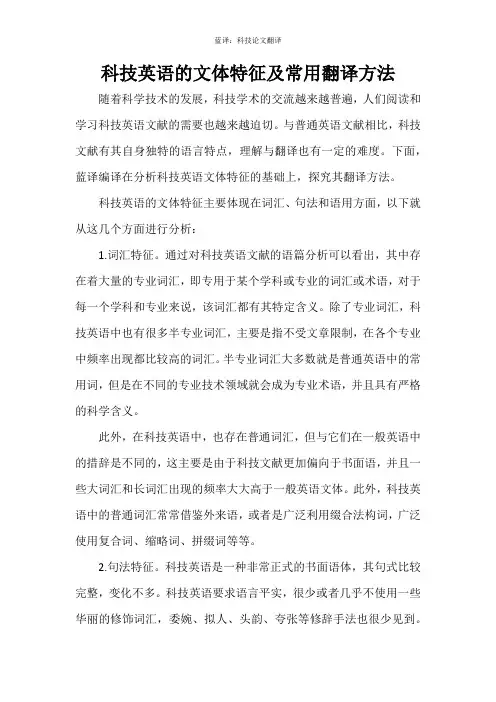
科技英语的文体特征及常用翻译方法随着科学技术的发展,科技学术的交流越来越普遍,人们阅读和学习科技英语文献的需要也越来越迫切。
与普通英语文献相比,科技文献有其自身独特的语言特点,理解与翻译也有一定的难度。
下面,蓝译编译在分析科技英语文体特征的基础上,探究其翻译方法。
科技英语的文体特征主要体现在词汇、句法和语用方面,以下就从这几个方面进行分析:1.词汇特征。
通过对科技英语文献的语篇分析可以看出,其中存在着大量的专业词汇,即专用于某个学科或专业的词汇或术语,对于每一个学科和专业来说,该词汇都有其特定含义。
除了专业词汇,科技英语中也有很多半专业词汇,主要是指不受文章限制,在各个专业中频率出现都比较高的词汇。
半专业词汇大多数就是普通英语中的常用词,但是在不同的专业技术领域就会成为专业术语,并且具有严格的科学含义。
此外,在科技英语中,也存在普通词汇,但与它们在一般英语中的措辞是不同的,这主要是由于科技文献更加偏向于书面语,并且一些大词汇和长词汇出现的频率大大高于一般英语文体。
此外,科技英语中的普通词汇常常借鉴外来语,或者是广泛利用缀合法构词,广泛使用复合词、缩略词、拼缀词等等。
2.句法特征。
科技英语是一种非常正式的书面语体,其句式比较完整,变化不多。
科技英语要求语言平实,很少或者几乎不使用一些华丽的修饰词汇,委婉、拟人、头韵、夸张等修辞手法也很少见到。
从科技英语文体的语篇分析来看,其句法特征主要体现在三个方面,一是“形式主语”和“形式宾语”的使用相对比较频繁;二是名词结构的使用较多;三是常出现被动语态。
3.语用特征。
简而言之,科技英语的语用特征,一是动名词的使用,二是模糊限制语的使用。
就前者来说,在翻译科技英语时,动名词的使用往往会给译者带来一定的困惑。
这主要是由于这些动名词经过了动词的虚化手段,然后又用来表示动作或者是动作的过程、结果产物或者是表示与某一事物相关的动作,所以有时候所表示的概念是比较抽象和含蓄的。
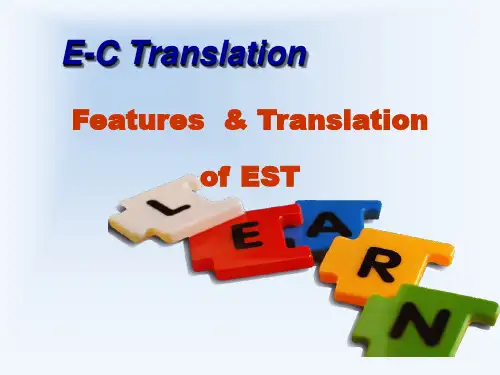
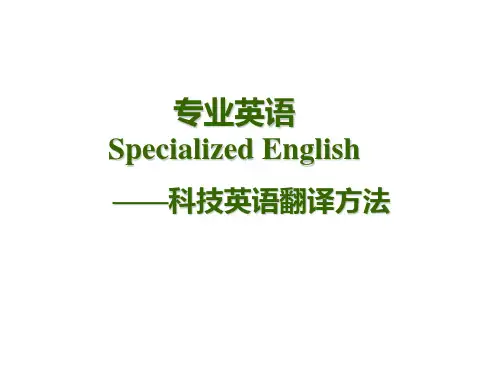
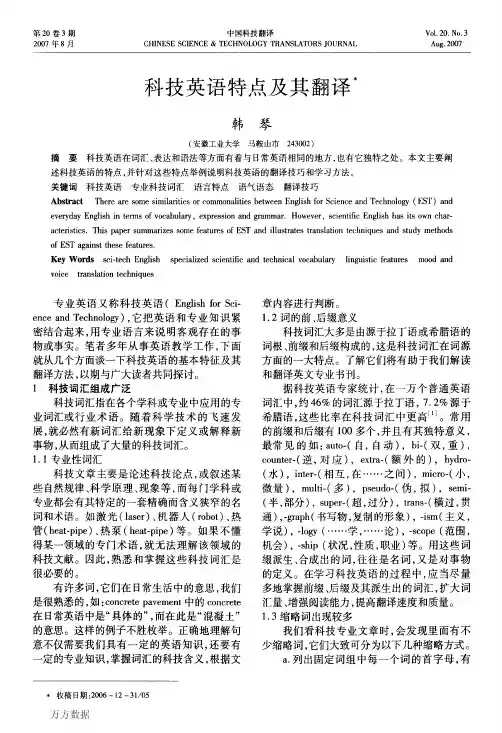


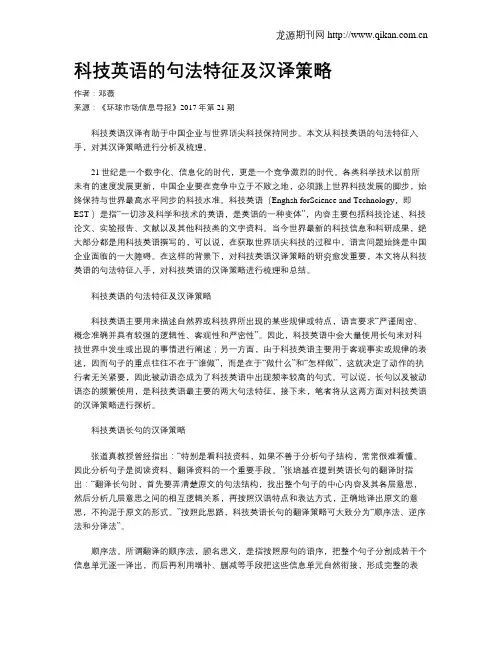
科技英语的句法特征及汉译策略作者:邓薇来源:《环球市场信息导报》2017年第21期科技英语汉译有助于中国企业与世界顶尖科技保持同步。
本文从科技英语的句法特征入手,对其汉译策略进行分析及梳理。
21世纪是一个数字化、信息化的时代,更是一个竞争激烈的时代。
各类科学技术以前所未有的速度发展更新,中国企业要在竞争中立于不败之地,必须跟上世界科技发展的脚步,始终保持与世界最高水平同步的科技水准。
科技英语(Enghsh forScience and Technology,即EST )是指“一切涉及科学和技术的英语,是英语的一种变体”,内容主要包括科技论述、科技论文、实验报告、文献以及其他科技类的文字资料。
当今世界最新的科技信息和科研成果,绝大部分都是用科技英语撰写的,可以说,在获取世界顶尖科技的过程中,语言问题始终是中国企业面临的一大障碍。
在这样的背景下,对科技英语汉译策略的研究愈发重要,本文将从科技英语的句法特征入手,对科技英语的汉译策略进行梳理和总结。
科技英语的句法特征及汉译策略科技英语主要用来描述自然界或科技界所出现的某些规律或特点,语言要求“严谨周密、概念准确并具有较强的逻辑性、客观性和严密性”。
因此,科技英语中会大量使用长句来对科技世界中发生或出现的事情进行阐述;另一方面,由于科技英语主要用于客观事实或规律的表述,因而句子的重点往往不在于“谁做”,而是在于“做什么”和“怎样做”,这就决定了动作的执行者无关紧要,因此被动语态成为了科技英语中出现频率较高的句式。
可以说,长句以及被动语态的频繁使用,是科技英语最主要的两大句法特征,接下来,笔者将从这两方面对科技英语的汉译策略进行探析。
科技英语长句的汉译策略张道真教授曾经指出:“特别是看科技资料,如果不善于分析句子结构,常常很难看懂。
因此分析句子是阅读资料、翻译资料的一个重要手段。
”张培基在提到英语长句的翻译时指出:“翻译长句时,首先要弄清楚原文的句法结构,找出整个句子的中心内容及其各层意思,然后分析几层意思之间的相互逻辑关系,再按照汉语特点和表达方式,正确地译出原文的意思,不拘泥于原文的形式。
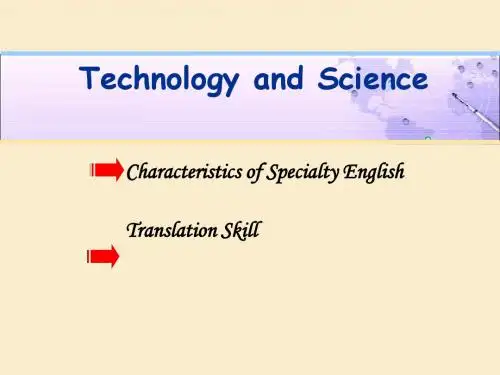
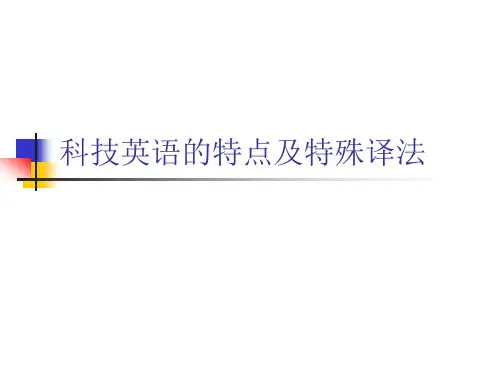
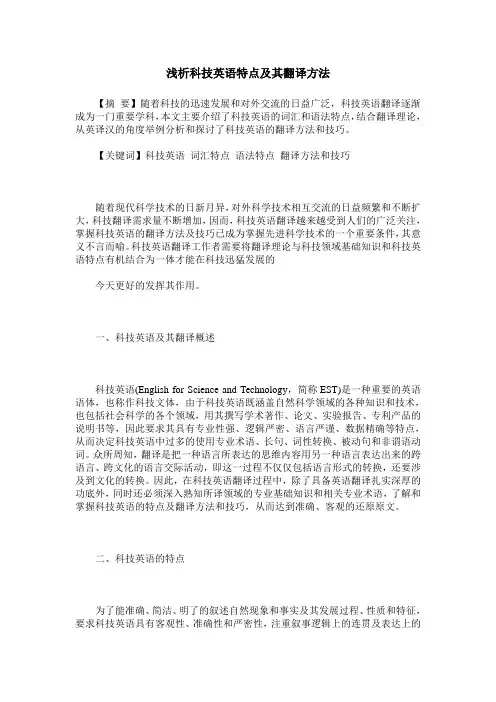
浅析科技英语特点及其翻译方法【摘要】随着科技的迅速发展和对外交流的日益广泛,科技英语翻译逐渐成为一门重要学科,本文主要介绍了科技英语的词汇和语法特点,结合翻译理论,从英译汉的角度举例分析和探讨了科技英语的翻译方法和技巧。
【关键词】科技英语词汇特点语法特点翻译方法和技巧随着现代科学技术的日新月异,对外科学技术相互交流的日益频繁和不断扩大,科技翻译需求量不断增加,因而,科技英语翻译越来越受到人们的广泛关注,掌握科技英语的翻译方法及技巧已成为掌握先进科学技术的一个重要条件,其意义不言而喻。
科技英语翻译工作者需要将翻译理论与科技领域基础知识和科技英语特点有机结合为一体才能在科技迅猛发展的今天更好的发挥其作用。
一、科技英语及其翻译概述科技英语(English for Science and Technology,简称EST)是一种重要的英语语体,也称作科技文体,由于科技英语既涵盖自然科学领域的各种知识和技术,也包括社会科学的各个领域,用其撰写学术著作、论文、实验报告、专利产品的说明书等,因此要求其具有专业性强、逻辑严密、语言严谨、数据精确等特点,从而决定科技英语中过多的使用专业术语、长句、词性转换、被动句和非谓语动词。
众所周知,翻译是把一种语言所表达的思维内容用另一种语言表达出来的跨语言、跨文化的语言交际活动,即这一过程不仅仅包括语言形式的转换,还要涉及到文化的转换。
因此,在科技英语翻译过程中,除了具备英语翻译扎实深厚的功底外,同时还必须深入熟知所译领域的专业基础知识和相关专业术语,了解和掌握科技英语的特点及翻译方法和技巧,从而达到准确、客观的还原原文。
二、科技英语的特点为了能准确、简洁、明了的叙述自然现象和事实及其发展过程、性质和特征,要求科技英语具有客观性、准确性和严密性,注重叙事逻辑上的连贯及表达上的明晰与畅达,避免行文晦涩。
科技英语力求平易和精确,避免使用旨在加强语言感染力和宣传效果的各种修辞格,以免使读者产生行文浮华、内容虚饰之感。
两分钟做个小测试,看看你的英语程度美联英语提供:科技英语翻译技巧科技英语翻译的5种常用翻译技巧1 顺译法:(Synchronizing)有些英语长句所表达的事物根本上是按照时间或逻辑的顺序安排的。
这与汉语表达的方法根本一致,因此翻译一般可以按照原文顺序译出。
例如:1(1) For these forms of pollution as for all the others, (2) the destructive chain of cause and effect goes back to a prime cause: (3) too many cars, too many factories, more and more trials left by supersonic jutes, inadequate methods for disinfecting sewers, too little water, too much carbon monoxide.这个句子是由一个主句、一个状语和一个同位语组成的。
主句是(2) 破坏的因果关系链可归根于一个主要原因,也是全句的中心内容。
主句前的(1)是方式状语,(3)是主句的同位语。
原文各句的逻辑关系、表达顺序与汉语完全一致,因此可以按照原文的顺序翻译。
译文:这些形式的污染象所有其他形式的污染一样,起破坏性的因果关系链可可归根于一个主要的原因:太多的汽车、工厂、洗涤剂、杀虫剂,越来越多的喷气式飞机留下的尾气,缺乏的污水消毒处理方法,太少的水源,太多的一氧化碳。
2 (1)Fossil fuel emit another 5.2 billion metric tons of CO2 into the air each year, (2) while the burning of tropical forests emits roughly 1.8 billion metric tons of CO2-(3) both contributing to a build up of carbon dioxide (4) that willsoon trigger the greenhouse effect. 在这个句子中,主句是(1),(2)是主句的并列句,(3)是同位语,(4)是定语从句。
科技英语特点及翻译标准CONTENTSCHAPTER ONE INTRODUCTION (1)1.1Demands of The New World (1)1.2English For Science and Technology (2)CHAPTER TWO FEATURES OF ENGLISH FOR SCIENCEAND TECHNOLOGY (2)2.1Definition of EST (2)2.2Lexical Features of EST (3)2.2.1Classification of EST lexicon (3)2.2.2Word formation in EST lexicon (6)2.3Syntax Features of EST (8)2.3.1Frequent use of the simple present tense (9)2.3.2Predominance use of the passive voice (9)2.3.3Extensive use of long sentences (11)2.3.4Normalization of EST (12)CHAPTER THREE CRITERIA OF ESTTRANSLATION (14)3.1Criteria of Translation (14)3.2Criteria of EST Translation (15)3.2.1Faithfulness (16)3.2.2Preciseness (17)3.2.3Conventionalization (18)3.2.4Conformity to the age (19)CHAPTER FOUR CONCLUSION (20)BIBLIOGRAPHY (22)CHAPTER ONE INTRODUCTION1.1 Demands of the New World…Knowledge explosion? and …information explosion? aretwo popular terms prevailing in the world today. Whether a country can acquire valuable knowledge and the latest information would doubtlessly matter greatly to its advance of science and technology and development of economy. (周方珠,2002:295).Over the last 50 years science and technology have developed rapidly all over the world. This expansion has been accompanied by an ever-increasing use of English in every area of scientific study. A UNESCO study(1957) estimated that something between 1 and 2 million scientific and technical articles,reports,patents and books were published annually,but about half of them were in English.Enormous and unprecedented expansion in scientific and economic activities created a world eagerly demanding for an international language, which fells to English.Since the middle of last century, an increasing number of the former colonies have gained independence. After achievements of political independence, they are aware that have to maintain and develop their independence with economic development. Thus the emerging third world began to plunge into their new program to develop their own economy, especially science and technology. The needs to introduce advanced science and technology from developed countriesmake it more important to learn English as a working tool.1.2 English for Science and TechnologyEnglish for science and technology took it first appearance in the 1950s when science and technology developed rapidly. As a significant international language, English was widely used in technical writings in exchange with scientific ideas. Generally speaking, it involved all written and spoken materials, and in thisthesis, only written EST texts are touched.As a communicative style to exchange information, EST demands that the writers should state matter-of-fact descriptions with concise words, and they should avoid using meaningless words to have messages rendered accurately and efficiently. To sum up, EST put emphasis on descriptions of objectivity, judgment of facts or the reasoning of logical definitions. Therefore, EST embodies accuracy, logicality and objectivity, different from literary English that tends to seek elegant style or carry strong personal emotions or inclinations of the authors.CHAPTER TWO FEATURES OF ENGLISH FORSCIENCE AND TECHNOLOGY2.1 Definition of ESTEnglish for science and technology(EST)is a functional varying style. It is a scientific and technological register formed by scientists and technicians to meet the needs of scientific communication. It is a language used by scientists and technicians in a special situation. From the register?s viewpoint, EST is the register of science and technology for modern English.The development of EST has something to do with the changing requirement of English learning and Halliday?s work on register analysis. Many British linguists are aware that EST presents linguistic varieties with its own characteristic features. Some typical sentence patterns and a large number of technical terms and semi- technical words make EST different to a very wide extent from ordinary English.2.2Lexical Features of ESTEvery field of study has its own specific vocabulary, but most people would agree that specific vocabulary of science and technology is particular large, obscure and splintered. Words arethe basic elements of language. Apparently, it is of vital importance to grasp the main lexical features of EST. Thus, this chapter is devoted to a brief exploration of EST lexicon.2.2.1Classification of EST lexiconV ocabulary is a most important feature of scientific writings. According to Peter Newmark, …Technical translation is primarily distinguished from other forms of translation by terminology, although terminology usually only makes up about 5-10% of a text? (Newmark, 2001:151).Since science and technology developed rapidly, more and more technical terms are formed and a large number of general words have adopted new meanings referred to technique, which makes the lexicon of EST distinguished from other texts in the first instance. A good mastery of it will benefit us a lot in the translation of EST texts.EST vocabulary would usually be divided into three categories: technical words, semi-technical words, and non-technical words.●Technical wordsTechnical words refer to words that can exactly explain definite concepts in specific field of science and technology. Words in this category seem to be a little difficult to understand in that they are not often used in general English texts and ask for special knowledge in that field for correct understanding. For example:electron 电子nuclear fission 原子核裂变metrology计量学matrass卵形瓶Photopolymer光聚合版sunspot 太阳黑子neutron中子pistil 雄蕊●semi-technical wordsSemi-technical terms are used more frequently. There are many words whose use is not only confined to scientific and technical contexts and which are an essential part of technical English. They can be found in both everyday English and EST texts. Their meanings related to science are quite different from general ones, which may be relevant. Here are a few examples: forwarding technology:转发技术test tube:试管imaging system:(印刷)成像系统carrier:电信公司,载波base:(计算机)基值;(无线电)基极force:(物)transmission:(无线电)发射;(医学)遗传;(物理)透射non-technical wordsSome words are not technical in a strict sense, but tend to occur Particularly frequently in technical English, such as functional words, auxiliary verbs, pronouns, numerals, etc, which constitutes eighty-five percent of EST lexicon. They seem to fit well into the precise, impersonal and formal English of scientists and engineers.EST word general wordconvert changemaximum greatestmaximize/minimize make as big/small as possibleidentical similarappreciable a lot ofWords in left column are just corresponds with the features of EST style,which is concise, precise and formal while those in right are more preferred to.2.2.2 Word formation in EST lexiconMany scientific and technical words are formed by means of word formation according to the basic rules of word formation.In terms of formation, English may be classified into three categories: single words, compound and phrases (e.g. anti-armored-fight-vehicle-missile). A brief introduction is given as follows:●AcronymAcronyms are formed with the initial letters, which are extensively used in scientific and technical English. They are very convenient to employ this brief form, For example:WTO—World Wide Trade Organization世界贸易组织DBMS—DataBase Management SystemBASIC—Beginner?s All-purpose Symbolic Instruction Code 初学者通用符号指令代码TOEFL—T est Of English as a Foreign Language作为外语的英语考试(托福)laser—light amplification by stimulated emission of radiation 激光radar—radio detecting and ranging 雷达●AffixationAffixation is an important means of creating new English words with prefix and suffix, which are treated as inseparable elements of the words being coined. Here are some examples: mini- 小型;微型sub- 在...下;亚;半minicomputer 微型计算机subzero 零下的minicam 小型照相机subsystem 子系统minicab 微型出租汽车subclinical 亚临床型的-ity electricity 电学-er propeller 螺旋桨●CompoundingCompounding is the way of combining at least two words to form a new one. (刘宓庆,1998:376)EST words created by compounding always appear with three forms:(1)with a hyphenobject-oriented 面向对象的plug-and-play 即插即用(2)without a hyphengreenhouse温室online在线(3)two or more words forming a word combinationaircraft carrier 航空母舰time-consuming operation 耗时操作●BlendingBlending is regarded as a variant of compounding, which omitted the latter part of the first word and clipping off the first part of the second word(刘宓庆,1998:377). Please observe the following examples:telex←teleprinter+exchange电传code c←coder+decoder编码译码器compuser←computer+user 计算机用户syscall←system+call 系统调用psywar←psychological + warfare心理战Blended words are found more often in EST texts than others. In this way, words of EST could be made shorter, and the sentences composed of these words could be made more concise.Proper NounsSome English technical terms are borrowed from proper nouns, such as names of person, places, organizations, trade marks, etc. For example, the word ‘Haier’actually originates from a trademark,‘Kuru? derives fr om a place in eastern New Guinea; And the capital of USA Washington is named after the first US president.2.4Syntax Features of ESTA sentence is a basic linguistic unit of a text, which can be treated as an independent element to perform the communicative function. The features are said to reflect thescientists' need for communication and exchanging ideas. To achieve objective, exact and concise statements, EST sentences need to be expressed in well-organized and logical structures. EST texts differ from general English in the use of simple present tense, passive voice, word orderand sentence construction. Let us discuss a few features in the coming paragraphs.2.3.1 Frequent use of the simple present tenseIt is well known that there are sixteen tenses in English. The simple present tense is frequently used in expressing the timeless general statement(无时间性的一般叙述),such as natural phenomenon, natural law, definition theorem, formula and so on(周方珠,2005:302). Since EST texts often contain information about truths or facts with no specific time reference, the present tense is commonly used in EST texts. There are mainly three circumstances to use the simple present tense in EST texts. Please observe the following examples:a.to describe a process(1) A scientist observes carefully, applies logical thought to hisobservations and tries to find relationships in datab.to state a scientific theory or facts(2) Sound travels through the air in waves.(3) Newton found that all masses attract one other.c.to describe habitual actions(4)Altering current is usually supplied to people's houses at 50 cycles persecond.2.3.2 Predominance use of the passive voiceIt is universally known that English is different from Chinese.Thepassive voice is quite often used in English while active voice is generally found in Chinese. It is assumed that one-third of the verbs in EST writings are in the passive voice. Since scientists are more interested in action and facts than the actors, many references to people are unnecessary and sometimes confusing, which in most cases are omitted. The using of passive voice achieves clearer meaning and more concise in structure and inclines to convey a passage impersonal and objective. What is more, it allows scientists to introduce the most important information at the very beginning. For example:(5) The results of the research are to be published soon.(6) Natural rubber is obtained from rubber trees as a white, milky liquidknown as latex. This is treated with acid and dried, before beingdispatched to countries all over the world.(7) The temperature of the liquid is raised by the application of heat.(8) The growth was affected by radiation.Anther pattern of passive model commonly found in EST texts is the …it?construction:is well knownis usually considerIt + should be made clear thathas been reportedcan be assumedWhile in instructions, warnings and notices, passive models areparticularly common. This type of passive construction maysuggest the formality of EST style.The passive voice is extremely useful and sometimes even regarded as mandatory in expressing objective ideas in EST, such as scientific or technical reports, where the actor is not the most important element and the concepts or principles being conveyed are of absolute importance. And in order to achieve objectivity, the passive voice is accordingly extensively used in EST texts.2.3.3 Extensive use of long sentencesScientific writings are usually put in long-sentence structure in a hope for precise and logical expression. Definitions, theorems, laws, concepts or the techniques may have in EST texts must be expressed accurately. Thus the use of modifier, qualifier or additional elements, verbal-infinitive phrases, prepositional phrases, adjectival phrases and compound nominal structure are quite frequently applied to simplification of long sentences. Here are some example sentences:(9)A robot a man so subtle that he seems to be not one but the incarnationof a winged angle, who can fly up to the skyscraper and hand in person the milk bottles to users, really a superman come into being on the earth —Robot.(10) Plastic is made from water which is a natural resource inexhaustibleand available everywhere, coal which can be minded through automaticand mechanical processes at least cost and lime which can be obtained from the calcinations of limestone widely present in nature.…(11) High melting point metals, carbides,oxides andnitrides are melted with a plasma-arc torch by coating objects with molten droplets carried in a jet of inert gas passed through the torch.(Mc Graw-Hill.1992,vol.6:p129)In example (9), the segregating constitutions range from the appositive …a man?as an inception to another appositive …a superman?as a terminus with …so…that? clause and …who? clause straggling between them; Though example (10) contains several clauses, the structures are clear and is easy to understand. Participle phrases employed in example (11) make the sentence quite concise and clear.2.3.4 Normalization of ESTNominalization is systematically correspondent to a clausal predication, which includes a head noun morphologically related to a corresponding verb. EST should adopt a concise or direct way of writing, containing objective thoughts, precise contents, and plenty of information or facts. Many modifications and restrictions are required to elaborate these concepts or ideas and the meaning of a noun phrase consisting of more than one word is usually complicated. In this way, nominalization is widely adopted. Nominalization is regarded as an important way to make sentence impersonal and compact, and is probably evolved at the very beginning in scientific andtechnical text, where it plays a dual role: to establish hierarchies of technical terms and to have an argument step by step, using complicated passages "packaged" in nominal form as Themes (Halliday, 1994:353).Thus nominalization is frequently used in EST texts. Look at the following examples:(12)The development of the rocket makes it possible for man to enterspace.(13)Archimedes first discovered the principle of displacement of water bysolid bodies.(14)Knowledge of the forces on the gear makes possible the determinationof its size.Rather than: If we know the force on the gear we can determine its size.(15) Discharge of contents of the tank is affected by a pump.Rather than: The contents of the tank are discharged by a pump.…The development of the rocket? and …for man to enter space? in example (12) are noun phrase, which make the sentence much more concise and logical. And in example (13), the noun phrase …the principle of displacement of water by solid bodies? not only simplifies the appositive sentence but also stresses the fact of displacement.Therefore, it is easy to conclude that nominalization leads to abstractness and inclusiveness and conciseness.CHAPTERTHREE CRITERIA OF EST TRANSLATION3.1 Criteria of TranslationAs is well known, translation is a complex and frustration task, which is regarded as a practical linguistic activity aiming at the inter-lingual communication. Translation criteria serve as the core of translation theory and the principle judging translation quality.Translation criterion is the mirror to reflect to what degree people's study of translation has been conducted. Obviously, translation criteria not only guide translating work but also develop translation theories. To be a qualified translator, one needs, above all, to be familiar with history and development oftranslation criteria.In China, whenever people discuss the principles of translation, they mention the three-character principle“信达雅”(faithfulness, expressiveness and elegance ) formulated by Yan Fu.Qu Qiubai said, …Tr anslation calls for the absolute correctness and pure Chinese vernacular, thus introducing the language of new culture to the reading public.?(刘重德,1991:21)According to Lin Yutang, there are no ready-made rules to follow in translating but only technical problems which are needed to be discussed. One technical problem is the criteria for judging translation, which he considers to be …faithfulness?(忠),…expressiveness?(顺) and …beautifulness?(美).Lu Xun, who agrees to "faithfulness" and "expressiveness" to such an extreme that he emphasizes he would rather be faithful to the original than be fluent in translation.In foreign studies, a lot of representative discussion has been devoted to how to produce an acceptable translation as well.In western world, the earliest and the most influential person on discussion of translation principles is Alexander Fraser Tytler. Tytler puts forward the following three principles:(1) The translation should give a complete transcript of the ideas of the original work.(2) The style and manner of writing should be of the same character as that of the original.(3) The translation should have all the ease of the original composition.Eugene A. Nida makes another influential translationcriterion by his translation equivalence. According to Newmark, a faithful translation attempts to reproduce the precise contextual meaning of the original within the constraints of the TL grammatical structures.3.2 Criteria of EST TranslationIn the past years there has been neglect in the research of criteria of science and technology translation. It seems that there is no further understanding in this issue than the school of “faithfulness ,expressiveness,elegance”,or the school of “loyalty ,smoothness”, both of which remain too general and impractical. The following paper attempts to present four principles to constitute interconnected dimensions of criteria of science and technology translation.3.2.1 FaithfulnessBy faithfulness in EST translation it refers to that the message of SL is correctly expressed in TL, it does not require that the grammar and sentence structure in SL should be the same as those in TL. …Faithfulness? in EST is, to some degree, not the same one involved in literary translation. Literary translation touches upon not only semantic equivalence, but also structures, rhetoric and positive and negative expressions. It is more complicated than EST translation in the principle of faithfulness. Here are some examples: (16) Velocity changes if either the speed or the direction changes.误:假如力的人小或方向改变了.速度跟着要变化。
《专业英语(制药工程)》【科技英语的常用句型和翻译技巧】一、概述1. 翻译的要求The Criteria of Translation:信、雅、达2. 科技英语词汇(上节课已经介绍)3. 科技英语句子的特点二、科技英语常用句型及翻译1. 被动语态1)被动语态的常用原因常用被动语态主要见于以下几个方面:①不必或无法说出主动者For a long time aluminum has been thought as an effective material for preventing metal corrosion.长期以来,铝被当作一种有效的防止金属腐蚀的材料。
►The book has already been translated into many languages.②强调行为对象,而非行为者,将行为对象作为句子的主语Three machines can be controlled by a single operation.三台机器能由一个操作者操纵。
►The work must be finished at once.③为了更好的联系上下文►They are going to build a library here next year. It is going to be build beside the classroom building.2)被动语句的翻译方法(1)仍译为被动句最常见的是在谓语前加上助词“被”,也可使用“受到,遭到,得到,叫,称,让,给,加以,为……所”等句式。
偶尔也可不加任何词直接译出。
We remember how air can be made into a liquid. If the liquid is warmed again, it “boiled”and turns back into a gas.我们记得是如何把空气制成液体的。
如果给这种液体重新加热,它“沸腾汽化”,就又还原成气体。
科技英语翻译技巧主要介绍三个方面的内容:科技英语特点、科技英语翻译的一般知识以及科技英语翻译的一般技巧。
一、科技英语特点1、以客观陈述为主,较多使用被动句科技人员在研究和解决科技问题时重视事物本身的客观规律、主观事实和方法、性能和特征,在讨论科技问题是力求客观而准确的陈述。
因此,在科技文献中通常以非人称的语气作客观的叙述,较多使用被动句。
例:The lengthof the polymer chainis specifiedby the number of repeatunitsin the chain. This is called the degree of polymerization. Unlike many products whose structure and reactions were well known before their industrial application, some polymers were produced onanindustrial scale longbefore their chemistryor physics was studied.2、大量使用科技词语科技文献中除了使用各学科专用的科技词语外,还广泛使用各学科通用的半科技词语和书面的非科技词语。
专用的科技词语仅用于某个学科或专业的词汇或术语。
半科技词语指那些日常用于英语,但又是科技英语中常用的那些词汇。
例:reaction。
书面非科技词语指主要用于科技英语但却严格地属于非科技性质的词语。
例:apply, to yield, generation, available,at the rate of 按~~的比率,以~~ 速度; in terms of 用、借助于3、表达方式程式化文章结构程式化:标题、摘要,正文(引言、论述、结论)。
(1 )介绍某个过程或功能及达到某种目标时,一般用动词不定式短语构成目的状语,放在句子的开头。
浅谈科技英语的特点及翻译标准和技巧随着科学技术的日新月异,迅猛发展,科技翻译越来越为人们所重视。
在进行科技英语翻译中,如何准确翻译出科技文本中的长句是译者必须面对的一大难题。
国内许多学者就科技英语长句翻译做过不少研究,对科技英语长句翻译策略的分析也不少见。
笔者由于工作关系,进行了大量的科技英语翻译,深感科技英语长句翻译有进一步研究探讨的必要。
科技英语翻译与普通英语文章的翻译有很大的区别,不论是在词汇和句法方面还是在表现形式等各方面,它都有着白己鲜明的特征。
不少人会认为,只要单纯地懂得了科技英语的专业词汇和语法规则,就能很好地理解并做好科技英语的翻译。
就他们而言,科技英语翻译仅仅只是科技英语的专业词汇和英语语法的简单结合,但是事实上并不是这样。
科技英语的翻译不仅对译者有很高的要求,而且还需要比较系统的了解科技英语的特点以及翻译原则,最重要的是还要掌握一定的翻译策略。
1 科技英语的特点有别于文学英语和其他形式的英语,科技英语的内容、表述、以及遣词造句都有自身特点。
归纳来说,总共分两大点,分别为科技英语的词语特点和句型结构的特点。
1.1 科技英语词语的特点科技英语在表述时多用直观、简单、准确、无歧义词汇。
有别于日常英语或文学英语那样具有感性形象思维,科技英语不具感情色彩,所以多使用正式规范的书面词语来替代具有同样意义的口语化的词语或短语。
同时,科技英语也不经常运用修辞手段,而是要准确表达客观规律,按清晰的逻辑思维来描述问题,所以语言简单,没有多余赘述。
因此在翻译时则需要考虑这些因素,增强译文中的逻辑关系,用词简洁,确保译文通顺无误。
1.2 科技英语句型结构的特点科技英语涉及科技中的科学技术、科学设备、试验过程等内容,一般描述和讨论客观事物,具有较强的客观性、准确性和严密性,其语言规范,逻辑性强,结构严密。
描述内容多为客观事实。
2 科技英语的翻译原则科技英语翻译多用于科学技术交流或者描述客观事实,目的明确。
科技英语的特点与翻译一、科技英语的特点科技英语(English for science and technology,EST)指与用于科学和技术交流方面的英语口语和书面语。
作为一种重要的英语语体,其特点主要体现在以下几个方面。
1、词汇方面大量使用专业词汇、复合词、缩略词及利用前后缀构成的派生词。
专业词汇意义专一,用来表示明确的含义。
科技词汇多源于希腊语和拉丁语,是因为这两种语言作为英语的重要来源,是世界上成熟最早和最完备的语言中的两种,词汇不再发生词形、词义上的变化,具有稳定性。
2、句子方面多使用长句和被动语态,大量使用名词化结构(nominalization)和非限定动词。
另外,各种成份(如介词短语、形容词及其短语、副词、分词及从句等)作定语并后置,多使用It…that…结构句型、被动结构句型、as结构句型、分词短语结构句型和省略句结构句型等常用句型。
名词化结构有利于行文简洁、表达客观、内容确切,也可使所含信息量增大,尤其是科技英语强调存在的事实,而非个别行为。
不定式短语、-ing分词短语和-ed分词短语这三种非限定动词形式具有齐备的语法功能,可代替各种从句,这样既可缩短句子,行文简练,结构紧凑,又比较醒目。
3、形态方面科技英语在时态运用上有限,多用过去时和现在时。
尤其是多用一般现在时,以表述无时间性的科学定义、定理、公式、现象、过程等。
另外,科技英语多用逻辑性语法词(logical grammatical operators),如表示原因的如because (of)、due (owing) to、as (a result of)、caused by、for等,表示语气转折的如but、however、nevertheless、otherwise、yet等,表示逻辑顺序的如so、therefore、thus、furthermore、moreover、in addition to等。
4、文体方面科技英语注重行文的连贯(coherence)、清晰(clarity)、流畅(fluency),避免行文晦涩、表露个人感情、过多运用修辞手法等。